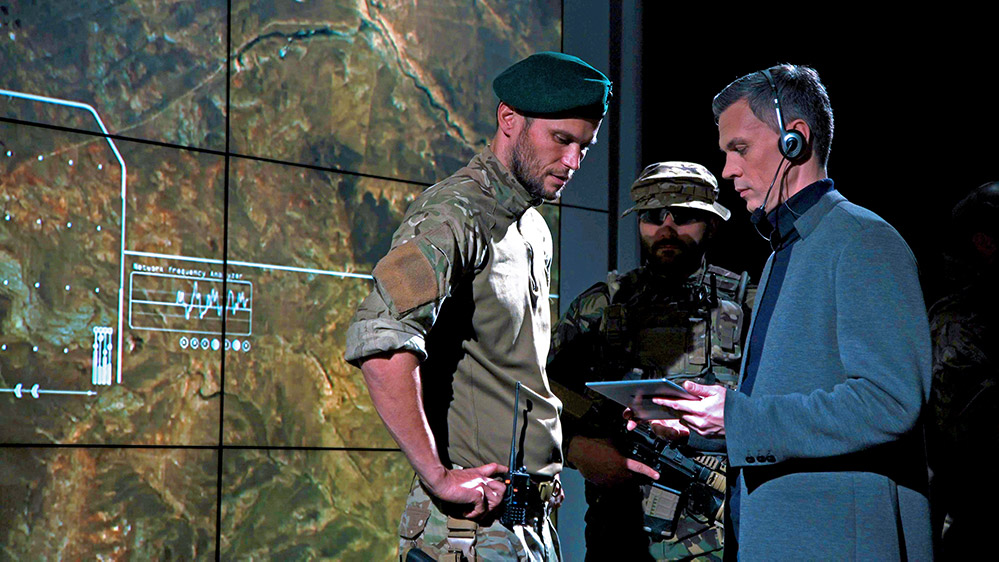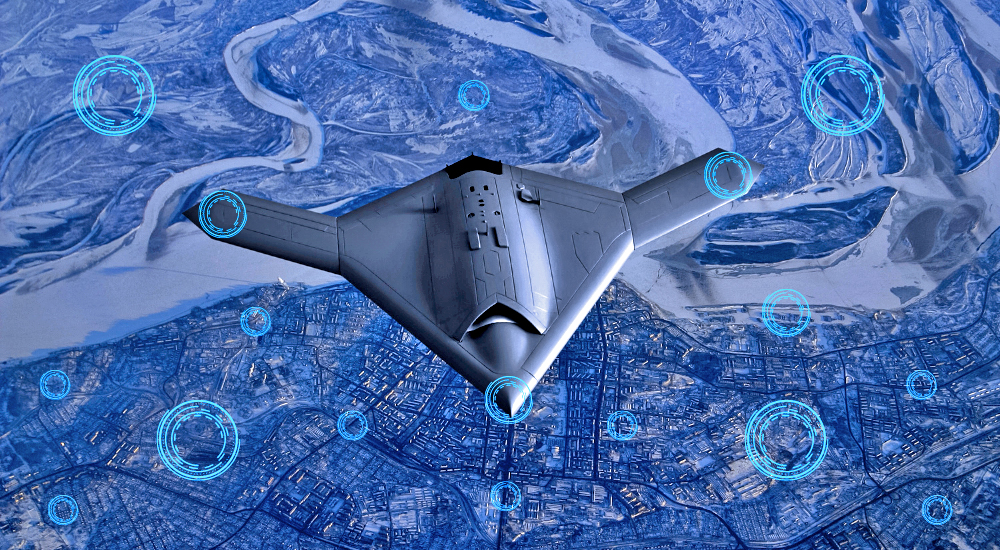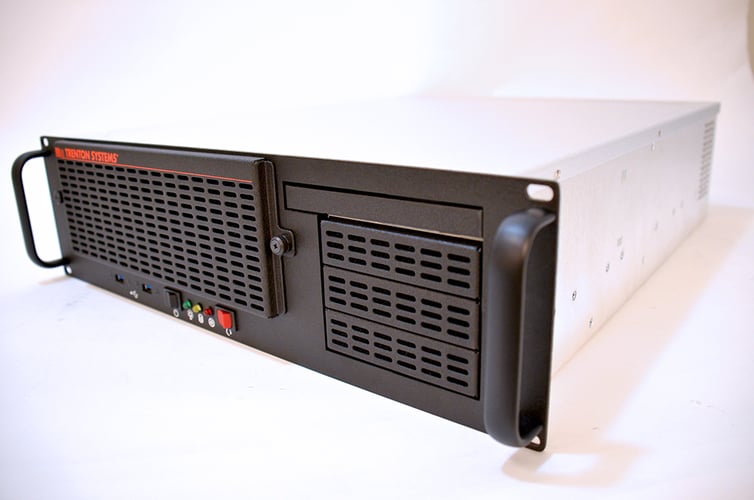Share this
5 Ways Edge Servers Improve UAV Military Programs, Applications
by Brett Daniel on Nov 16, 2020 8:43:57 AM
.png?width=690&name=Untitled%20design%20(60).png)
Graphic: An illustration of an edge computing architecture with tactical edge servers, a UAV, and various IoT sensors
Unmanned aerial vehicles (UAVs), inclusively and increasingly known as remotely piloted aircraft (RPA), are and will continue to be a vital intelligence, surveillance, and reconnaissance (ISR) solution in the internet of military things, internet of battlefield things, the Joint All-Domain Command and Control (JADC2) tactical edge network, whatever you’d like to call the military’s ongoing, overarching implementation of edge computing technologies.
The UAV’s ability to quickly and effectively acquire and transmit geographical data, identify and track targets using object recognition technologies, and engage the enemy during missions that would ordinarily be too difficult, time-consuming, or dangerous for human servicemembers is truly unmatched. Its ground pilots and sensor operators help warfighters, commanders, and other key military personnel execute their missions swiftly and purposefully, but like any military technology, it’s not perfect.
Delays in transmitting and processing sensor-acquired data from the environment so that the UAV and its ground operators can respond quickly and accordingly is a good place to start. Thankfully, edge computing can mitigate much of this delay, as you’ll soon see. There’s also, for example, the challenge of effectively tracking objects and targets located in high-traffic urban areas with lots of buildings, urban canopy, and other structures. This is just one of many issues that can’t be solved by simply deploying a few edge servers… or can it?
In this blog post, we’ll discuss five ways in which edge servers improve UAV programs and applications for the military. At the end, we’ll talk about rugged edge servers, specifically, and some things to keep in mind for your UAV edge server deployments.

Graphic: Deploying rugged servers at the edge can significantly improve the data analytics process.
1. Improved data analytics
Low latency is a frequently touted benefit of edge computing and edge servers in general, and it remains the most important. That’s because it’s at the core of what gives military technologies like UAVs the ability to do what they do best – monitor, collect, relay, and engage – faster. By locating edge servers closer to the UAV’s area of interest, its sensors now have a nearby hub with which to send data for analysis. In the case of missions where time is of the essence, such as with active combat, stealth, and target tracking, this nearly instantaneous send-and-receive relationship is vital.
Normally, significant delays in data transfer would occur if the sensor-acquired data was forced to travel long distances to a far-flung cloud data center for computation. Couple this with the copious amounts of network data already traveling to and from the data center, and you’ve encountered both a distance and a bandwidth problem. Deploying local edge servers in nearby ground stations, small-scale data centers, or transit cases can actually cut down on both by moving computation closer to the source of data and reducing network traffic to the cloud, resulting in a smoother, more efficient data analytics process for locally collected intelligence.
![]()
Graphic: Research has shown that deploying edge servers can help UAVs keep track of their targets more effectively.
2. Better target tracking
Research published last year demonstrated that deploying an edge computing cluster near UAVs operating in more urbanized environments and offloading the UAV's video processing and analysis from the cloud to said edge computing cluster can improve target tracking by reducing network latency, improving reliability, and boosting optimal quality of experience (QoE).
Surveillance data from UAVs is typically sent to the cloud for processing and analysis, but as we've already mentioned, this is often not without wide-area-network delays. In the case of target tracking, the introduction of edge servers that take on this processing and analysis at the local level could be the defining factor in whether a UAV loses or maintains its target, particularly in environments plagued by numerous office buildings, parking garages, and high pedestrian and vehicle traffic - that is, most large cities.
The researchers looked at whether installing a local network of ground security cameras and offloading the cloud's analysis of the UAV's video data to a local cluster of mobile phones, laptops, and yes, edge servers, collectively known as the edge computing cluster, would be an effective strategy to mitigate delays in data processing, and as a result, allow the UAV to keep a steady eye on its target.
Quite frankly, the researchers explain the relationship better than we ever could.
Firstly, a UAV collects the video about a target in a real-time manner, and then it transmits the data to the ground computing cluster to analyze and recognize the target, and then the result is fed back to the UAV for further tracking guidance.... Secondly, when the UAV is about to lose track of the target, it needs to ask the ground surveillance cameras system to continue the tracking, and collect the surrounding information and transmit them to the nearby computing cluster for computation and recognition. Once the target is found again by a ground camera, the UAV can fly to the relevant location to continue tracking according to the geographic location information of the ground camera.... Thirdly, in the worst-case scenario, in which the target is completely lost, all video data from nearby cameras need to be obtained right from the place where the target was lost, in order to find the target again. In order to quickly find the target again, the large amount of the computation tasks can be offloaded into a nearby ground computing cluster.
- UAV-aided urban target tracking system based on edge computing, Yajun Liu, Congxu Zhu, Xiaoheng Deng, Peiyuan Guan, Zhiwen Wan, JieLuo, Enlu Liu and Honggang Zhang
You can read the full report here.
3. Enhanced common operational picture (COP)
With local data analysis improved and network latency and traffic reduced, commanders and other key military leaders can take advantage of an enhanced common operational picture (COP).
We all know what it's like to have to wait on the results of a server bogged down by requests, whether this server's located at your office or at a distant cloud data center. Retrieving a file can take forever. Application disruptions occur. Sending a file or loading a simple webpage can be a nightmare. The request for a specific action from your application dies in its tracks. Now, scale this issue to the battlespace, where many sensors and devices interacting with one another are constantly requesting data from the cloud. One can only imagine the delays and disruptions caused by such a bogged-down network.
By introducing edge servers into the tactical network architecture, delays in data processing between the UAV's sensors, deployed IoT sensors - such as those attached to soldiers - ground control stations, command and control, and other local IoT devices and military installations are mitigated. A glorified subnetwork has been created for the purpose of offloading computation from the cloud.
And because delays in data transfer and processing are now reduced and overall network traffic lowered, commanders across the Army, Navy, Marine Corps, and Air Force can view the battlefield or area of interest at large with a greater degree of real-time accuracy, which speeds up critical decision-making and makes for a more efficiently executed mission overall.

Photo: Lower latency and reduced network traffic gives UAV pilots, sensor operators, and other servicemembers the data they need quicker, which, in turn, can provide a boost to the rate at which critical mission decisions are made.
4. Faster decision-making
As foreign adversaries bolster their artificial intelligence (AI) and machine learning (ML) footprint within the battlespace, faster decision-making by way of edge computing will be at the core of the United States' fight to remain competitive. UAVs, edge computing, edge servers, network latency, bandwidth, and COPs aside, split-second decision-making when it matters most is what it all boils down to.
Within the DoD's JADC2 tactical edge network, enabling the proliferation of readily available UAV data that supports a series of mission-critical decisions across the Navy, Army, Air Force, and Marine Corps is where edge servers will show up and show out.
Think about the wealth of data that UAV sensors are providing UAV pilots, sensor operators, warfighters, commanders, and other servicemembers, from tracking data about key targets and objects in the environment, to navigational data, insights about the terrain, weather, and more. Some of this data is crucial intelligence that would ordinarily be extremely difficult for servicemembers to acquire at best and outright dangerous to acquire at worst. The same goes for other IoT sensors in the field, such as IoT sensors on military vehicles like tanks and Humvees.
By introducing servers closer to where this data is being generated, or at the edge, you can get important UAV data into the hands of warfighters and commanders faster and more effectively, equipping them with the insights they need to change the course of a mission, destroy a mine, locate a dangerous target, take the fork in the road instead of continuing straight ahead, and most importantly, save innocent lives.

Graphic: The DoD's JADC2 tactical network will take advantage of the UAV's ISR and other capabilities more effectively by utilizing edge servers and other edge computing technologies.
5. Efficiency in all-domain collaboration
Because Congress and the DoD continue to stress the possibility, or, assuming the worst, the inevitability, of the United States falling behind in technological warfare across the globe, we feel it's important to discuss their initiatives that, in theory, prevent this from happening.
The JADC2 tactical network is one of many DoD initiatives - see, for instance, the JEDI Cloud - aimed at keeping the country, at the very least, computationally competitive with its adversaries. It connects each branch of the military to enable some of the benefits we've discussed in this very blog post: improved situational awareness and faster decision-making. But where do UAVs and edge servers fit within this complex concept of all-domain collaboration?
Well, think of this network, which is really just a glorified example of an edge computing architecture, like the human body. The IoT sensors on the UAV and scattered throughout the field are your eyes, ears, and sense of touch, continuously gathering information about your surroundings, and the local edge servers are your brain propelling your body to respond to the stimuli encountered in this hypothetical environment. They're literally your computational fight or flight.
Now, connect these sensors across each branch of the military: Army, Navy, Air Force, and Marine Corps. What do you have? Well, you have the JADC2 tactical network - a cohesive, interconnected ecosystem of sensors pulling data from air, land, and sea simultaneously to improve all-domain situational awareness.
Now, introduce UAVs. They can collect large amounts of environmental data from each of these environments and empower warfighters and commanders to act. Now, introduce edge servers, which take this raw data and make sense of it quickly thanks to their locale. Finally, with all its real-time capabilities resulting from efficient data transference and analysis, you've got the force of the future, ready to retain its dominance in the technological battlespace for years to come.

Photo: There are a few key considerations to keep in mind when looking for edge servers that fit your UAV program or application.
Conclusion: Ruggedized edge servers for UAV programs, applications
When it comes to deploying edge servers for UAV programs and applications, make sure you find a server manufacturer with the following:
- In-house support team, to prevent 45-minute wait times and unproductive support calls with individuals who will have no firsthand knowledge of your rugged computing solution
- Revision and obsolescence control, to ensure you get the right hardware for your solution every time and receive end-of-life notices at the right time
- A reasonable loaner program, particularly a risk-free program with no hidden fees, that allows you test both components and systems, and of course, one with the longest trial period
- In-house compliance testing, because your edge server will likely need MIL-STD-810 and DO-160 testing for shock, vibe, temperature, or humidity, and why waste time and money shopping around for these certifications when they can all be handled in one place?
- A selection of both commercial off-the-shelf and customizable hardware and BIOS solutions, because you never know what you might need in a system as the trajectory of your program or application changes
- Components that are made in the USA, because it's an increasing focus of the DoD due to the Pentagon's inability to verify the pedigree of its microelectronics, and because USA design, manufacture, assembly, integration, testing, and support for rugged computing solutions can, with an effective quality control program, Counterfeit Protection Program (CPP), and trusted partners, significantly reduce the likelihood of your sensitive data being compromised
To learn more about UAVs and rugged computing solutions, check out Ground Control Stations: The Lifeblood of Remotely Piloted Aircraft (RPA).
As always, we at Trenton Systems are here to help you find the right rugged computing solution for your needs and yours alone. Trenton Systems' ruggedized edge servers are the ideal choice for UAV programs and applications placing emphases on seamless performance, durability, reliability, and cybersecurity across all dimensions of the battlespace.
Choose from a list of available options, or let us customize a secure rugged computing solution just for you. We'll guide you through the process every step of the way.
Share this
- High-performance computers (42)
- Military computers (38)
- Rugged computers (32)
- Cybersecurity (25)
- Industrial computers (25)
- Military servers (24)
- MIL-SPEC (20)
- Rugged servers (19)
- Press Release (17)
- Industrial servers (16)
- MIL-STD-810 (16)
- 5G Technology (14)
- Intel (13)
- Rack mount servers (12)
- processing (12)
- Computer hardware (11)
- Edge computing (11)
- Rugged workstations (11)
- Made in USA (10)
- Partnerships (9)
- Rugged computing (9)
- Sales, Marketing, and Business Development (9)
- Trenton Systems (9)
- networking (9)
- Peripheral Component Interconnect Express (PCIe) (7)
- Encryption (6)
- Federal Information Processing Standards (FIPS) (6)
- GPUs (6)
- IPU (6)
- Joint All-Domain Command and Control (JADC2) (6)
- Server motherboards (6)
- artificial intelligence (6)
- Computer stress tests (5)
- Cross domain solutions (5)
- Mission-critical servers (5)
- Rugged mini PCs (5)
- AI (4)
- BIOS (4)
- CPU (4)
- Defense (4)
- Military primes (4)
- Mission-critical systems (4)
- Platform Firmware Resilience (PFR) (4)
- Rugged blade servers (4)
- containerization (4)
- data protection (4)
- virtualization (4)
- Counterfeit electronic parts (3)
- DO-160 (3)
- Edge servers (3)
- Firmware (3)
- HPC (3)
- Just a Bunch of Disks (JBOD) (3)
- Leadership (3)
- Navy (3)
- O-RAN (3)
- RAID (3)
- RAM (3)
- Revision control (3)
- Ruggedization (3)
- SATCOM (3)
- Storage servers (3)
- Supply chain (3)
- Tactical Advanced Computer (TAC) (3)
- Wide-temp computers (3)
- computers made in the USA (3)
- data transfer (3)
- deep learning (3)
- embedded computers (3)
- embedded systems (3)
- firmware security (3)
- machine learning (3)
- Automatic test equipment (ATE) (2)
- C6ISR (2)
- COTS (2)
- COVID-19 (2)
- CPUs (2)
- Compliance (2)
- Compute Express Link (CXL) (2)
- Computer networking (2)
- Controlled Unclassified Information (CUI) (2)
- DDR (2)
- DDR4 (2)
- DPU (2)
- Dual CPU motherboards (2)
- EW (2)
- I/O (2)
- Military standards (2)
- NVIDIA (2)
- NVMe SSDs (2)
- PCIe (2)
- PCIe 4.0 (2)
- PCIe 5.0 (2)
- RAN (2)
- SIGINT (2)
- SWaP-C (2)
- Software Guard Extensions (SGX) (2)
- Submarines (2)
- Supply chain security (2)
- TAA compliance (2)
- airborne (2)
- as9100d (2)
- chassis (2)
- data diode (2)
- end-to-end solution (2)
- hardware security (2)
- hardware virtualization (2)
- integrated combat system (2)
- manufacturing reps (2)
- memory (2)
- mission computers (2)
- private 5G (2)
- protection (2)
- secure by design (2)
- small form factor (2)
- software security (2)
- vRAN (2)
- zero trust (2)
- zero trust architecture (2)
- 3U BAM Server (1)
- 4G (1)
- 4U (1)
- 5G Frequencies (1)
- 5G Frequency Bands (1)
- AI/ML/DL (1)
- Access CDS (1)
- Aegis Combat System (1)
- Armed Forces (1)
- Asymmetric encryption (1)
- C-RAN (1)
- COMINT (1)
- Cloud-based CDS (1)
- Coast Guard (1)
- Compliance testing (1)
- Computer life cycle (1)
- Containers (1)
- D-RAN (1)
- DART (1)
- DDR5 (1)
- DMEA (1)
- Data Center Modular Hardware System (DC-MHS) (1)
- Data Plane Development Kit (DPDK) (1)
- Defense Advanced Research Projects (DARP) (1)
- ELINT (1)
- EMI (1)
- EO/IR (1)
- Electromagnetic Interference (1)
- Electronic Warfare (EW) (1)
- FIPS 140-2 (1)
- FIPS 140-3 (1)
- Field Programmable Gate Array (FPGA) (1)
- Ground Control Stations (GCS) (1)
- Hardware-based CDS (1)
- Hybrid CDS (1)
- IES.5G (1)
- ION Mini PC (1)
- IP Ratings (1)
- IPMI (1)
- Industrial Internet of Things (IIoT) (1)
- Industry news (1)
- Integrated Base Defense (IBD) (1)
- LAN ports (1)
- LTE (1)
- Life cycle management (1)
- Lockheed Martin (1)
- MIL-S-901 (1)
- MIL-STD-167-1 (1)
- MIL-STD-461 (1)
- MIL-STD-464 (1)
- MOSA (1)
- Multi-Access Edge Computing (1)
- NASA (1)
- NIC (1)
- NIC Card (1)
- NVMe (1)
- O-RAN compliant (1)
- Oil and Gas (1)
- Open Compute Project (OCP) (1)
- OpenRAN (1)
- P4 (1)
- PCIe card (1)
- PCIe lane (1)
- PCIe slot (1)
- Precision timestamping (1)
- Product life cycle (1)
- ROM (1)
- Raytheon (1)
- Remotely piloted aircraft (RPA) (1)
- Rugged computing glossary (1)
- SEDs (1)
- SIM Card (1)
- Secure boot (1)
- Sensor Open Systems Architecture (SOSA) (1)
- Small form-factor pluggable (SFP) (1)
- Smart Edge (1)
- Smart NIC (1)
- SmartNIC (1)
- Software-based CDS (1)
- Symmetric encryption (1)
- System hardening (1)
- System hardening best practices (1)
- TME (1)
- Tech Partners (1)
- Total Memory Encryption (TME) (1)
- Transfer CDS (1)
- USB ports (1)
- VMEbus International Trade Association (VITA) (1)
- Vertical Lift Consortium (VLC) (1)
- Virtual machines (1)
- What are embedded systems? (1)
- Wired access backhaul (1)
- Wireless access backhaul (1)
- accredidation (1)
- aerospace (1)
- air gaps (1)
- airborne computers (1)
- asteroid (1)
- authentication (1)
- autonomous (1)
- certification (1)
- cognitive software-defined radios (CDRS) (1)
- command and control (C2) (1)
- communications (1)
- cores (1)
- custom (1)
- customer service (1)
- customer support (1)
- data linking (1)
- data recording (1)
- ethernet (1)
- full disk encryption (1)
- hardware monitoring (1)
- heat sink (1)
- hypervisor (1)
- in-house technical support (1)
- input (1)
- integrated edge solution (1)
- international business (1)
- licensed spectrum (1)
- liquid cooling (1)
- mCOTS (1)
- microelectronics (1)
- missile defense (1)
- mixed criticality (1)
- moving (1)
- multi-factor authentication (1)
- network slicing (1)
- neural networks (1)
- new headquarters (1)
- next generation interceptor (1)
- non-volatile memory (1)
- operating system (1)
- output (1)
- outsourced technical support (1)
- post-boot (1)
- pre-boot (1)
- private networks (1)
- public networks (1)
- radio access network (RAN) (1)
- reconnaissance (1)
- rugged memory (1)
- secure flash (1)
- security (1)
- self-encrypting drives (SEDs) (1)
- sff (1)
- software (1)
- software-defined radios (SDRs) (1)
- speeds and feeds (1)
- standalone (1)
- storage (1)
- systems (1)
- tactical wide area networks (1)
- technical support (1)
- technology (1)
- third-party motherboards (1)
- troposcatter communication (1)
- unlicensed spectrum (1)
- volatile memory (1)
- vpx (1)
- zero trust network (1)
- January 2025 (1)
- November 2024 (1)
- October 2024 (1)
- August 2024 (1)
- July 2024 (1)
- May 2024 (1)
- April 2024 (3)
- February 2024 (1)
- November 2023 (1)
- October 2023 (1)
- July 2023 (1)
- June 2023 (3)
- May 2023 (7)
- April 2023 (5)
- March 2023 (7)
- December 2022 (2)
- November 2022 (6)
- October 2022 (7)
- September 2022 (8)
- August 2022 (3)
- July 2022 (4)
- June 2022 (13)
- May 2022 (10)
- April 2022 (4)
- March 2022 (11)
- February 2022 (4)
- January 2022 (4)
- December 2021 (1)
- November 2021 (4)
- September 2021 (2)
- August 2021 (1)
- July 2021 (2)
- June 2021 (3)
- May 2021 (4)
- April 2021 (3)
- March 2021 (3)
- February 2021 (8)
- January 2021 (4)
- December 2020 (5)
- November 2020 (5)
- October 2020 (4)
- September 2020 (4)
- August 2020 (6)
- July 2020 (9)
- June 2020 (11)
- May 2020 (13)
- April 2020 (8)
- February 2020 (1)
- January 2020 (1)
- October 2019 (1)
- August 2019 (2)
- July 2019 (2)
- March 2019 (1)
- January 2019 (2)
- December 2018 (1)
- November 2018 (2)
- October 2018 (5)
- September 2018 (3)
- July 2018 (1)
- April 2018 (2)
- March 2018 (1)
- February 2018 (9)
- January 2018 (27)
- December 2017 (1)
- November 2017 (2)
- October 2017 (3)
/Trenton%20Systems%20Circular%20Logo-3.png?width=50&height=50&name=Trenton%20Systems%20Circular%20Logo-3.png)

Comments (2)